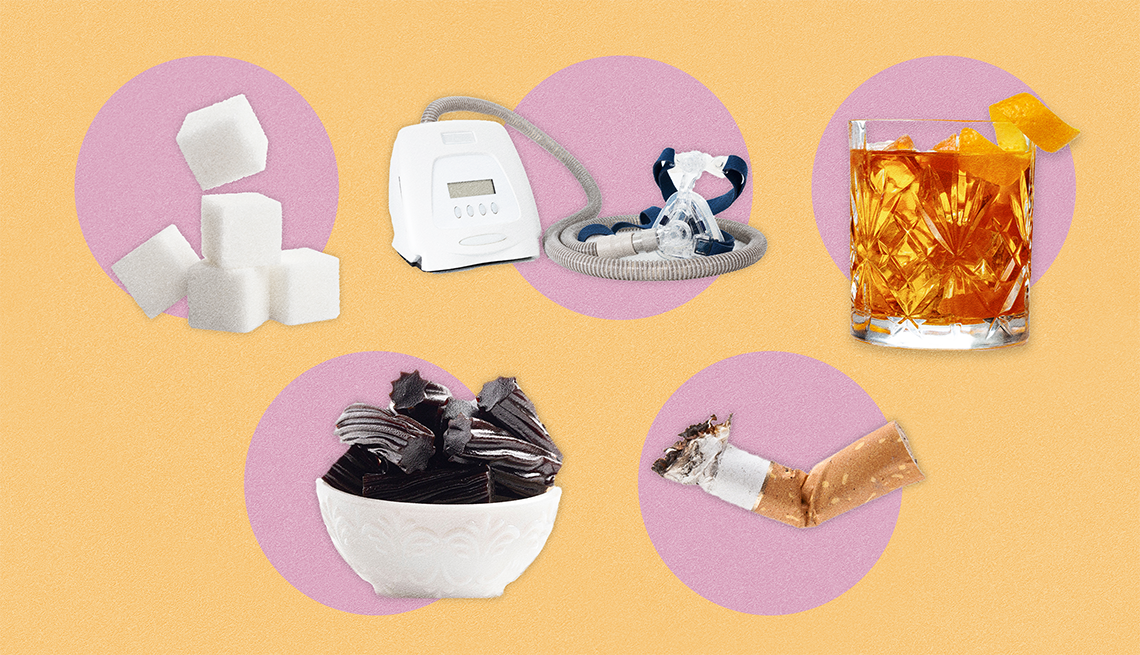AARP Hearing Center


High Blood Pressure Guide
- Symptoms, causes and tests
- Stages and types
- Treatment and prevention
- High blood pressure myths
- Alcohol and blood pressure
- Hypertension headache myths
- Smoking and high blood pressure
- Anxiety, stress and hypertension
- Is hypertension genetic?
- Medications that raise blood pressure
- Home blood pressure monitoring
- Surprising causes of hypertension
People who watch their blood pressure are generally familiar with the more common factors that can cause their numbers to spike — salt and stress, for example.
But a handful of unsuspected foods, habits and health issues can play a role, too, and sabotage well-intentioned efforts to lower high blood pressure, or hypertension, a condition that affects nearly half of U.S. adults.
Here are 12 surprising things that can send your numbers soaring.
1. Sleep apnea
Sleep apnea, a sleep disorder in which a person stops and restarts breathing several times throughout the night, can cause a bump in blood pressure. And it’s becoming increasingly common in the U.S. as more Americans struggle with being overweight, says Donald Lloyd-Jones, M.D., chair of the Department of Preventive Medicine at Northwestern University Feinberg School of Medicine and former president of the American Heart Association. Excess weight is one of the foremost risk factors for developing sleep apnea; age is another big one.
Why is high blood pressure dangerous?
High blood pressure can wreak havoc on the body, causing damage to the blood vessels, heart, brain, kidneys, eyes and more. If left undetected or uncontrolled, it can lead to:
- Heart attack
- Stroke
- Heart failure
- Kidney disease
- Vision loss
- Sexual dysfunction
- Angina
- Peripheral artery disease
Nearly half of U.S. adults have high blood pressure; only about 1 in 4 adults have it under control.
Source: American Heart Association, Centers for Disease Control and Prevention
When a person with sleep apnea stops breathing, the brain steps in and wakes the body up to take a breath; this can happen up to 30 times an hour. “And when we don’t get good quality sleep — and particularly if we’re not getting good quality sleep because our airway gets closed and our brain and our body has to maintain enough awareness to try to open up the airway — that is very, very hard on the vascular system,” Lloyd-Jones says.
All the stress and strain drives up blood pressure — “and not just when we’re asleep, but also when we’re awake for the rest of the day,” Lloyd-Jones says. It can cause a whole host of other health issues, too, including an increased risk for heart attack, type 2 diabetes and liver problems. Researchers at Johns Hopkins Medicine found that severe sleep apnea in middle or old age can increase risk of premature death by up to 46 percent.
A common warning sign of sleep apnea is snoring, so if someone tells you that you snore loudly or gasp often during sleep, it may warrant a discussion with your health care provider. A number of devices and therapies can help to treat sleep apnea, and studies suggest that treatment with one of the more common options — a continuous positive airway pressure (CPAP) machine — may even improve blood pressure numbers.
2. An unpredictable sleep schedule
It’s not just apnea during your sleep cycle that can cause your blood pressure to go through the roof. “People who don’t get six to eight hours of uninterrupted sleep can have elevated blood pressure,” says Luke Laffin, M.D., codirector of the Center for Blood Pressure Disorders at the Cleveland Clinic.
Several studies have found that sleepless nights raise blood pressure not only throughout the night, but the next day as well.
For quality sleep, go to bed and wake up at the same time every day, avoid drinking and eating 90 minutes before bed, and don’t watch television in bed. If you wake up and are unable to get back to sleep in 20 minutes, get up and do something else, Laffin says.
3. Holding it when you have to go
When you have a full bladder but wait to urinate until the next rest stop or commercial break, your body increases your blood pressure. “A full bladder raises blood pressure about 10 to 15 points,” Laffin explains. That’s why he and his colleagues encourage people to urinate before they measure their blood pressure, particularly if they’re doing so to monitor the medications they’re taking at home.
“It’s fine to hold your urine if you’re in a situation where you cannot urinate freely. But if you have to urinate and can use the restroom, then you shouldn’t necessarily delay,” he says. So do a preemptive pee before heading into the theater or beginning a long car ride.
Speaking of urination, getting up frequently at night to relieve yourself may be a sign of hypertension. “If your blood pressure is elevated, that causes the body to say, ‘I need to lower my blood pressure.’ One way to do that is to urinate,” Laffin says.






























































More on Health
Best Exercise for Lowering Blood Pressure
New study finds this is #18 Ways to Get Heart Healthy
American Heart Association checklist now includes key components of cardiovascular health, from diet to sleep habits
11 Superfoods for Heart Health
Eat these to lower blood pressure, fight inflammation and slash heart disease and stroke riskTry These Tips for Living a Healthier Life
Small changes can add up to big mental and physical results